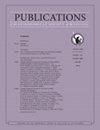Ejecta Masses in Type Ia Supernovae—Implications for the Progenitor and the Explosion Scenario* * Based in part on observations obtained with the Hobby-Eberly Telescope (HET), which is a joint project of the University of Texas at Austin, the Pennsylvania State University, Ludwig-Maximillians-Universitaet Muenchen, and Georg-August Universitaet Goettingen. The HET is named in honor of its principal benefactors, William P. Hobby and Robert E. Eberly.
IF 7.7
3区 物理与天体物理
Q2 ASTRONOMY & ASTROPHYSICS
Publications of the Astronomical Society of the Pacific
Pub Date : 2024-09-03
DOI:10.1088/1538-3873/ad6e18
引用次数: 0
Abstract
The progenitor system(s) as well as the explosion mechanism(s) of thermonuclear (Type Ia) supernovae are long-standing issues in astrophysics. Here we present ejecta masses and other physical parameters for 28 recent Type Ia supernovae inferred from multiband photometric and optical spectroscopic data. Our results confirm that the majority of SNe Ia showIa 型超新星的抛射物质量--对原生星和爆发情景的启示* * 部分数据基于霍比-埃伯利望远镜(HET)的观测结果,该望远镜是德克萨斯大学奥斯汀分校、宾夕法尼亚州立大学、路德维希-马克西米利大学慕尼黑分校和乔治-奥古斯特大学戈廷根分校的联合项目。HET 以其主要赞助人 William P. Hobby 和 Robert E. Eberly 命名。
热核(Ia 型)超新星的原生系统和爆炸机制是天体物理学中长期存在的问题。在这里,我们介绍了根据多波段测光和光学光谱数据推断出的最近28个Ia型超新星的喷出物质量和其他物理参数。我们的结果证实,大多数Ia型超新星的可观测喷出物质量低于钱德拉塞卡极限(平均Mej ≈ 1.1 ± 0.3 M⊙),这与最近的亚钱德拉塞卡爆炸模型的预测一致。它们与假定单衰变或双衰变原生体配置的模型是兼容的。我们还恢复了一个1.2 M⊙ < Mej < 1.5 M⊙内的超新星子样本,它们与近钱德拉塞卡爆炸相一致。考虑到推断出的喷出物质质量的不确定性,大约有一半的SNe与这两种爆炸模型相吻合。我们将我们的结果与以前的研究结果进行了比较,并讨论了应用方法的注意事项和关注点。
本文章由计算机程序翻译,如有差异,请以英文原文为准。
求助全文
约1分钟内获得全文
求助全文
来源期刊
CiteScore
6.70
自引率
5.70%
发文量
103
审稿时长
4-8 weeks
期刊介绍:
The Publications of the Astronomical Society of the Pacific (PASP), the technical journal of the Astronomical Society of the Pacific (ASP), has been published regularly since 1889, and is an integral part of the ASP''s mission to advance the science of astronomy and disseminate astronomical information. The journal provides an outlet for astronomical results of a scientific nature and serves to keep readers in touch with current astronomical research. It contains refereed research and instrumentation articles, invited and contributed reviews, tutorials, and dissertation summaries.

 求助内容:
求助内容: 应助结果提醒方式:
应助结果提醒方式:


